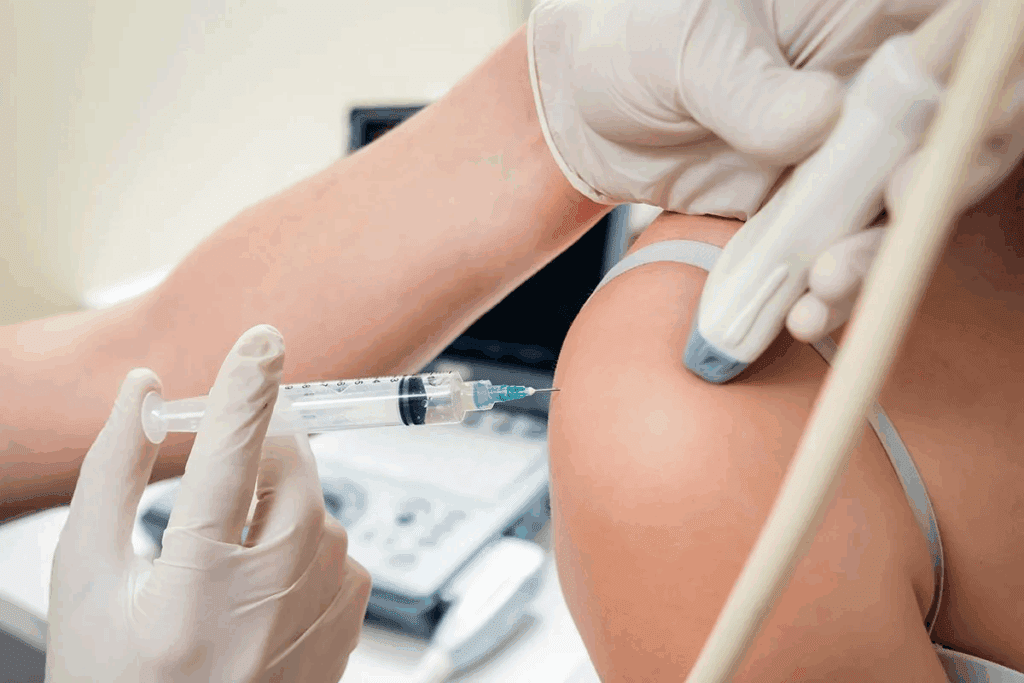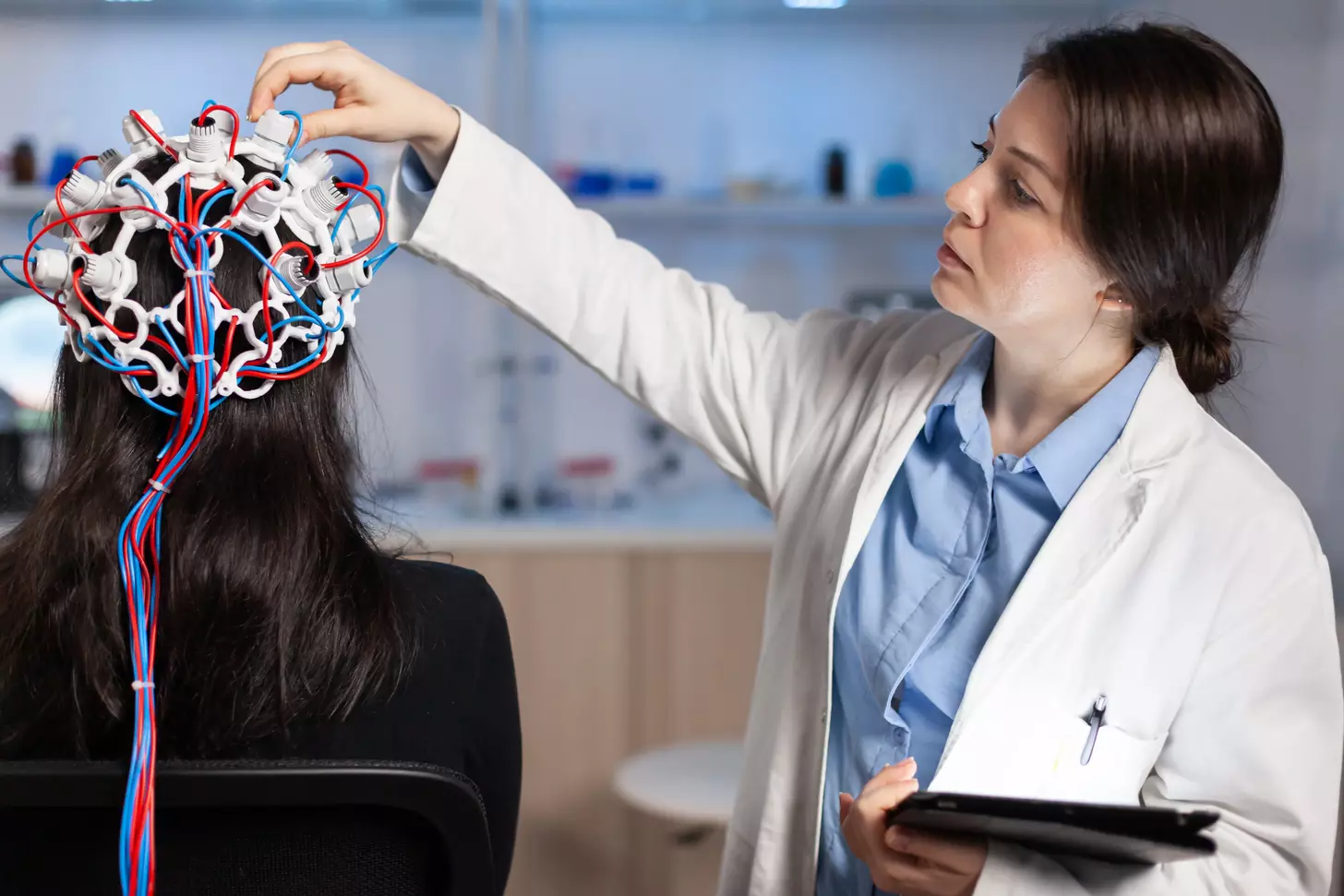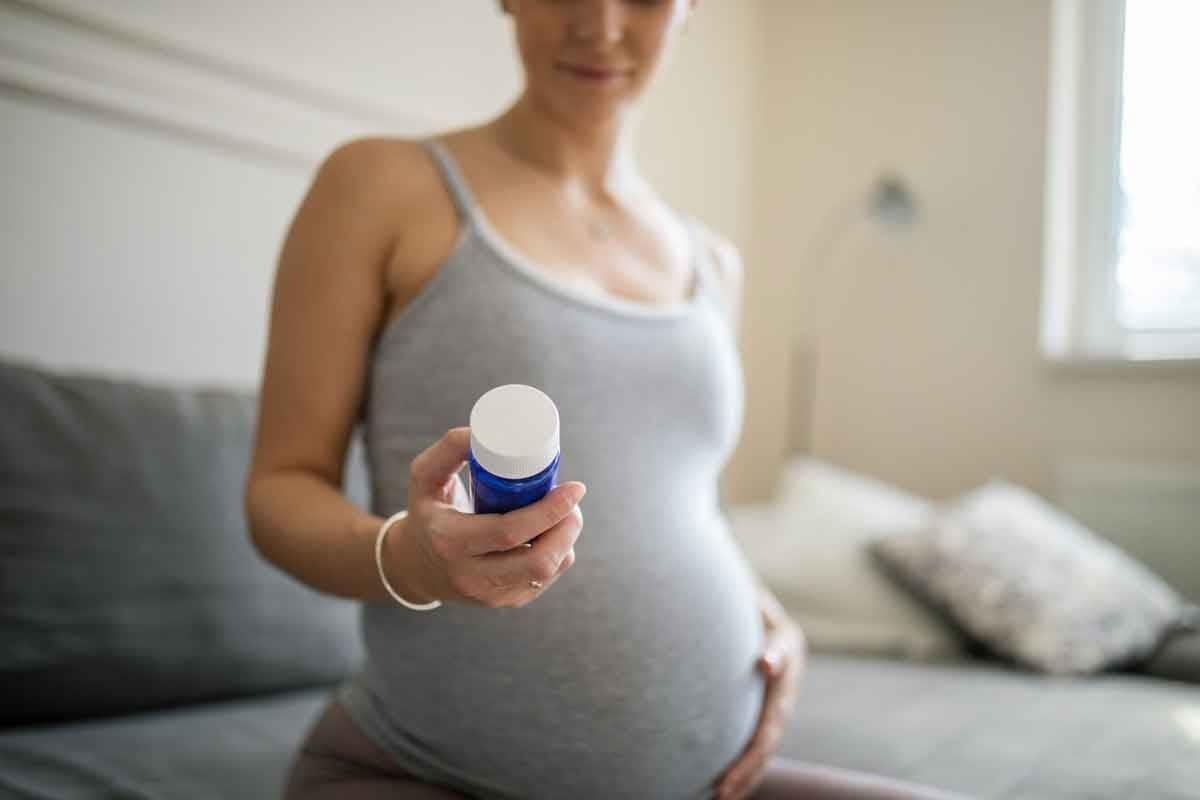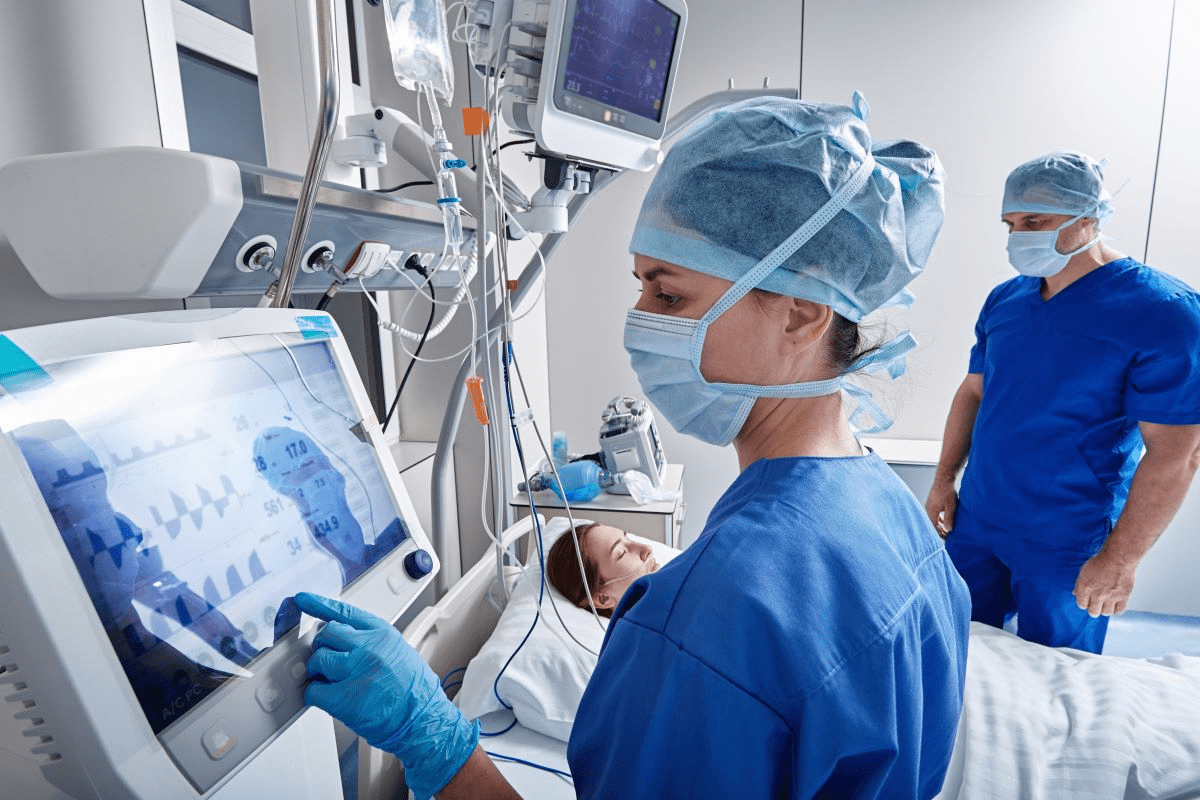Last Updated on November 26, 2025 by Bilal Hasdemir

Getting an accurate diagnosis is key for good treatment, when imaging finds something odd. A CT scan guided biopsy is a way to get tissue samples without a big cut. It uses live images to find and take samples from odd tissues.
At LivHospital, we use this method to show our commitment to top-notch care. The CT biopsy procedure lets doctors find and take samples from odd spots very accurately. This makes the process less painful and safer for patients.
This article will walk you through how to do a CT biopsy procedure. It will show how accurate it is and how biopsy ct scan helps get exact diagnoses.
Key Takeaways
- CT scan guided biopsy is a minimally invasive diagnostic technique.
- Real-time CT imaging ensures precise targeting of abnormal tissues.
- The procedure minimizes patient discomfort and risk.
- Liv Hospital is committed to internationally benchmarked care.
- CT guided needle biopsy is a critical diagnostic tool.
Understanding CT Guided Biopsies

CT-guided biopsies are key in today’s medical world. They help diagnose and manage diseases with precision and less invasiveness. This method is vital for getting tissue samples.
Definition and Clinical Applications
CT-guided biopsy uses CT scans to guide a needle into tissues. It’s used to sample tissues from different body parts. This includes the lungs, liver, and bones. It’s used to find cancer, infections, and inflammation.
Clinical applications of CT-guided biopsies include:
- Diagnosis of lung nodules and masses
- Sampling of liver lesions
- Biopsy of bone lesions
- Diagnosis of infections and inflammatory conditions
Types of Tissues Commonly Sampled
CT-guided biopsies can take samples from various tissues. This depends on the lesion’s location and type. Commonly, they sample lung, liver, and bone tissues.
| Tissue Type | Common Indications |
| Lung Tissue | Diagnosis of lung cancer, infections |
| Liver Tissue | Diagnosis of liver metastases, hepatitis |
| Bone Tissue | Diagnosis of bone metastases, osteomyelitis |
Diagnostic Accuracy and Yield Rates
CT-guided biopsies are very accurate and effective. They have a high success rate, often over 90% for lung lesions. This is because CT scans guide the needle precisely.
The diagnostic accuracy of CT-guided biopsies is a significant advantage in patient management, enabling healthcare providers to make informed decisions regarding treatment options.
These biopsies are essential in medicine today. They provide accurate tissue samples. This helps in starting the right treatment quickly, improving patient care.
Indications and Contraindications

Choosing to do a CT biopsy needs careful thought. It’s a key tool for doctors, but it must fit the patient’s needs and health history.
Medical Conditions Requiring CT Biopsy
CT biopsy helps diagnose many health issues, when other tests don’t work. It’s often used for lung nodules, liver, kidney, and lymph node samples.
Common Indications:
- Suspicious lung nodules or masses
- Liver or kidney lesions
- Lymphadenopathy
- Pancreatic lesions
When CT Guidance is Preferred Over Other Methods
CT guidance is better for some cases because it offers clear images. It’s great for small or hard-to-reach lesions that ultrasound or fluoroscopy can’t reach.
| Guidance Method | Advantages | Preferred Use |
| CT Guidance | High spatial resolution, accurate targeting | Small or deep-seated lesions |
| Ultrasound Guidance | Real-time imaging, no radiation | Superficial lesions, fluid collections |
| Fluoroscopic Guidance | Real-time imaging, useful for vascular procedures | Vascular interventions, certain bone procedures |
Absolute and Relative Contraindications
CT biopsy is usually safe, but there are exceptions. You can’t do it if the patient can’t stop bleeding or if they’re too scared. Other times, like severe lung problems, might also stop you.
Risk-Benefit Assessment
Before a CT biopsy, weighing the risks and benefits is key. You need to think about possible side effects like bleeding or lung problems. Doctors from different fields should talk it over together.
Pre-Procedure Patient Preparation
Getting ready for a CT-guided biopsy is key to its success and safety. Good preparation helps get accurate results and lowers risks. It makes sure the procedure goes smoothly.
Required Laboratory Tests and Imaging
Before the CT biopsy, some lab tests are needed. They check the patient’s health and look for risks. These tests are:
- Complete Blood Count (CBC) to check for anemia, infection, or bleeding disorders.
- Coagulation studies to assess the risk of bleeding.
- Blood chemistry tests to evaluate kidney function and other factors.
Also, recent imaging like CT scans or MRI might be reviewed. This helps guide the biopsy.
Medication Management and Anticoagulation
Patients must tell their doctor about all medications. This includes blood thinners like warfarin, aspirin, or clopidogrel. These might need to be stopped before the procedure to avoid bleeding.
“The management of anticoagulation therapy is critical in patients undergoing invasive procedures like CT-guided biopsy. The decision to stop or modify anticoagulant medication should be made in consultation with the patient’s healthcare provider.”
| Medication | Action Required | Timing |
| Warfarin | Stop | 5 days before the procedure |
| Aspirin | Stop | 7-10 days before procedure |
| Clopidogrel | Stop | 5-7 days before procedure |
Fasting Requirements
Patients usually need to fast for 6 to 8 hours before the CT biopsy. The exact time might vary based on the healthcare team’s instructions.
Patient Education and Informed Consent
Teaching patients about the CT biopsy is very important. They need to know what the procedure is, its benefits, risks, and what to expect. They must give informed consent after they’ve asked questions and understood the information.
Key elements of patient education include:
- Explanation of the procedure and its purpose.
- Discussion of possible risks and complications.
- Instructions before the procedure, like fasting and managing medications.
- What to do after the procedure and follow-up instructions.
Equipment and Materials for CT Biopsy Procedure
CT biopsy procedures use advanced imaging and special tools to get tissue samples. The right equipment and materials are key to success.
CT Scanner Specifications and Settings
The CT scanner is vital for these procedures. Modern scanners with high-resolution imaging and rapid acquisition times are best. The settings depend on the patient’s size, the target area, and the biopsy type.
For biopsies, the CT scanner uses low dose settings to reduce radiation. The kilovoltage (kVp) and milliampere-seconds (mAs) are set to ensure clear images.
Biopsy Needles and Co-axial Systems
Biopsy needles are made for precise tissue sampling. The choice between fine-needle aspiration (FNA) and core needle biopsy (CNB) varies by scenario. Co-axial systems allow for multiple samples from one site, making the procedure more efficient.
| Needle Type | Gauge | Length | Application |
| Fine Needle | 20-25G | 5-15 cm | Cytology samples |
| Core Needle | 14-18G | 10-20 cm | Histological samples |
Specimen Collection Materials
Materials for collecting specimens include formalin containers for histology and slides or liquid-based cytology media for cytology. It’s important to handle and label specimens correctly for accurate diagnosis.
Emergency Equipment and Medications
Having emergency equipment and medications ready is critical. This includes resuscitation equipment, oxygen supply, and medications for managing complications like bleeding or allergic reactions.
Having the right equipment and materials is key for safe and effective CT biopsy procedures. Knowing how to use these tools helps healthcare professionals improve patient care.
Patient Positioning and Initial CT Scan
The first step in a CT-guided biopsy is to position the patient correctly. This ensures the lesion is targeted accurately. The position depends on the lesion’s location, the biopsy method, and the patient’s comfort.
Optimal Positioning Based on Target Location
Positioning changes based on where the lesion is. For example, lung or liver lesions need special positioning. This might be lying down, on the stomach, or on the side.
The goal is to get the best access to the lesion safely. This reduces the risk of problems.
Immobilization Techniques
To keep the patient steady, immobilization techniques are used. Straps, pillows, or other devices help hold the position. This is key for a precise and safe biopsy.
Initial Scanning Parameters
The first CT scan uses settings tailored for the biopsy. The right slice thickness, voltage, and current are chosen. These settings help see the lesion and nearby areas clearly.
They might change based on the patient’s size and the lesion’s location. This ensures the best images for the biopsy.
Identifying the Safest Approach Path
The operator then picks the safest path for the biopsy needle. They avoid important structures and risks like bleeding. The path must allow for accurate sampling of the lesion.
Getting patient positioning and the initial CT scan right is key to a successful CT-guided biopsy. These steps improve the biopsy’s accuracy, safety, and success. This leads to better care for the patient.
Performing the CT Biopsy Procedure: Step-by-Step
A CT-guided biopsy is a detailed process that needs careful steps. It’s a key tool for doctors to diagnose diseases. Knowing each step is vital.
Sterile Field Preparation
The first step is to set up a sterile area. This means cleaning and disinfecting the skin where the biopsy will happen. Then, the area is covered with sterile drapes, and all tools are ready.
Keeping everything clean is very important. It helps avoid infections. The area must stay clean during the whole procedure.
Local Anesthesia Administration
Using local anesthesia helps the patient feel less pain. The type of anesthetic and how it’s given depends on where and how deep the biopsy is.
Good anesthesia makes the biopsy easier and more accurate. It helps the patient stay calm and comfortable.
Needle Insertion Technique
How the biopsy needle is placed is very important. It’s done by aligning the needle with the target under CT guidance. Then, it’s moved to the right spot.
Getting the needle in the right place is key for a good biopsy. CT scans help doctors see where the needle is in real time.
CT Confirmation of Needle Placement
After the needle is in, CT scans check if it’s in the right spot. This step is very important. It makes sure the biopsy sample is from the right area.
| Step | Purpose | Key Considerations |
| Sterile Field Preparation | Prevent infection | Maintain asepsis throughout |
| Local Anesthesia | Minimize discomfort | Choose appropriate anesthetic |
| Needle Insertion | Obtain accurate sample | Use CT guidance |
| CT Confirmation | Verify needle placement | Ensure accurate sampling |
Real-Time CT Guidance Techniques
During a CT guided biopsy, real-time guidance is key for precise needle placement. These methods help navigate the body’s complex anatomy and avoid complications.
Breath-Holding Instructions for Patient
Clear breath-holding instructions are given to the patient. This is vital because any movement can mess up the needle’s placement. Patients are told to hold their breath at the end of expiration for consistent scans.
Incremental CT Scanning During Procedure
Incremental CT scanning means taking many CT scans during the biopsy. This lets the doctor see the needle’s path in real-time and adjust as needed. Scans are taken at short intervals for a step-by-step view of the needle’s journey.
Needle Path Adjustments
As the needle moves towards the target, needle path adjustments might be needed. These adjustments are made based on the real-time CT images. This ensures the needle is placed correctly in the target tissue.
Advanced Guidance Technologies
The field of CT guided biopsies is growing, with advanced guidance technologies improving accuracy and safety. New software and robotic systems are being developed. These advancements aim to make CT guided biopsies even better.
| Technique | Description | Benefit |
| Breath-Holding Instructions | Patients are instructed to hold their breath at a specific point. | Ensures consistency across CT scans. |
| Incremental CT Scanning | Multiple CT scans are taken during the procedure. | Allows for real-time monitoring and adjustments. |
| Needle Path Adjustments | Adjustments are made based on real-time CT images. | Ensures accurate needle placement. |
Specimen Handling and Processing
The quality of CT-guided biopsy results depends a lot on how well the specimen is handled and processed. This step is key to making sure the samples are good for diagnosis. It affects how well patients are cared for and what treatments they get.
Immediate Specimen Assessment
Right after getting the biopsy sample, a quick check is done to see if it’s good enough for tests. This is very important to know if the sample can be used for looking at tissues.
Key factors assessed during immediate evaluation include:
- Sample size and integrity
- Presence of representative tissue
- Any visible abnormalities
Proper Labeling and Transportation
It’s very important to label and transport the sample to the lab right. Labels need to have the patient’s info, what kind of sample it is, and any important details about the patient.
For transport, use containers that keep the sample safe and prevent damage or contamination.
Pathology Processing Requirements
The lab follows set rules to handle the samples, like fixing, cutting, and staining them. The exact steps depend on the type of tissue and what the doctors think might be wrong with it.
| Specimen Type | Processing Requirement | Typical Turnaround Time |
| Soft Tissue | Formalin fixation, paraffin embedding | 24-48 hours |
| Bone | Decalcification, paraffin embedding | 48-72 hours |
| Cytology Samples | Direct smear, alcohol fixation | 24 hours |
Rapid On-Site Evaluation Techniques
Rapid on-site evaluation (ROSE) lets a pathologist or cytotechnologist check the sample right away during the biopsy. This helps see if the sample is good enough and might mean taking more samples if needed.
Following strict rules for handling and processing samples is key to giving the best care to patients getting CT-guided biopsies.
Post-CT Biopsy Procedure Care and Monitoring
After a CT-guided biopsy, it’s key to watch patients closely. This is to catch any issues early and keep them safe. The care after the biopsy is just as important as the biopsy itself for a good recovery.
Immediate Post-Procedure Observations
Right after the biopsy, doctors look for any signs of trouble. This includes bleeding or reactions to the contrast used. Close monitoring means they can act fast if something goes wrong.
Vital Signs Monitoring Protocol
Doctors keep a close eye on patients with a special monitoring plan. They check blood pressure, heart rate, oxygen levels, and breathing rate often. Continuous monitoring helps spot problems early, so they can be treated right away.
Imaging Follow-up
Some patients need more imaging after the biopsy. This is to see how well the biopsy went and if there are any issues. The type of imaging needed depends on the biopsy and the patient’s situation.
Discharge Criteria
Before leaving the hospital, patients must meet certain criteria. They need to have stable vital signs and no big problems. They also need to be able to take care of themselves at home. Clear instructions are given on what to do next, including follow-up visits and wound care.
Good care after a CT biopsy is all about paying attention to the details. It’s about putting the patient first. By sticking to the right protocols, doctors can make sure patients do well after their biopsies.
Conclusion: Advances and Future Directions in CT Guided Biopsies
The field of CT-guided biopsies has seen big improvements. These changes have made diagnoses more accurate and procedures safer. As technology keeps getting better, we can expect even more progress in advances in CT guided biopsies.
New directions in CT guided needle biopsy will likely use advanced imaging and artificial intelligence. This will help make the CT biopsy procedure even better. It will allow doctors to get accurate diagnoses with less risk to patients.
As doctors keep using and improving these technologies, patients will get better care. The ongoing growth of CT guided biopsies shows how important it is to keep up with the latest in this field.
FAQ
What is a CT guided biopsy?
A CT guided biopsy uses a CT scan to guide a needle to take tissue samples. This is done to help diagnose diseases.
What are the benefits of CT guided biopsy?
CT guided biopsy is very accurate and minimally invasive. It can target specific areas of the body.
What types of tissues are commonly sampled during a CT guided biopsy?
Common tissues sampled include lung, liver, kidney, and bone. Also, lymph nodes and soft tissue masses are often checked.
How is a patient prepared for a CT guided biopsy?
Preparation includes lab tests and managing medications. Patients also fast and learn about the procedure and risks.
What is the role of CT scan guidance in ensuring accuracy during a biopsy?
CT scan guidance provides real-time images. This helps place the needle accurately, reducing risks and improving results.
What are the indications for a CT guided biopsy?
It’s used for suspicious lesions or masses seen on scans. It’s also for undiagnosed conditions and to guide treatment.
What are the contraindications for a CT guided biopsy?
Contraindications include uncorrectable bleeding issues and severe low platelet counts. Also, if a patient can’t follow instructions.
How is the biopsy needle inserted during a CT guided biopsy?
The needle is inserted under CT guidance. It’s done with a sterile technique and local anesthesia. The path is planned to avoid vital structures.
What happens to the biopsy specimen after it is obtained?
The specimen is handled and processed according to pathology needs. This includes immediate assessment and proper labeling for transport to the lab.
What is the role of rapid on-site evaluation during a CT guided biopsy?
Rapid on-site evaluation (ROSE) checks the specimen immediately. It ensures it’s adequate and provides early diagnostic clues, guiding further sampling if needed.
What care is provided after a CT guided biopsy?
Post-procedure care includes monitoring vital signs and watching for complications. Imaging follow-up may be needed, and the patient is discharged when ready.
What are the advantages of using CT guidance over other imaging modalities for biopsy?
CT guidance has high spatial resolution and can image various tissues. It offers real-time guidance, making it great for complex lesions.
Are there any risks or complications associated with CT guided biopsy?
Like any invasive procedure, CT guided biopsy has risks. These include bleeding, infection, and damage to nearby structures. But these are rare with proper technique and patient selection.
Reference:
- Balbi, M. (2025). CT-guided transthoracic needle biopsy: How we do it. ScienceDirect. Retrieved from https://www.sciencedirect.com/science/article/pii/S0720048X25000804






